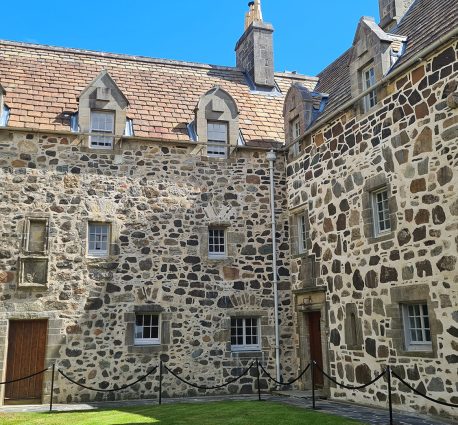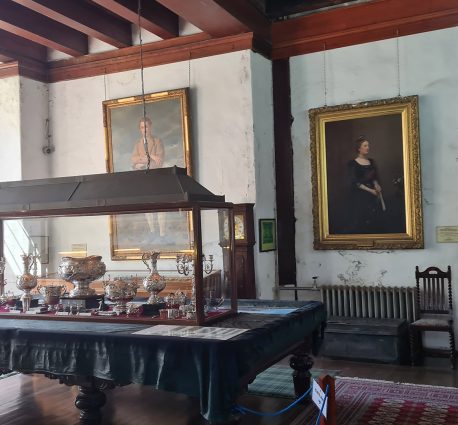Duart Castle, or Caisteal Dhubhairt in Scottish Gaelic, stands as an imposing and historically significant fortress on a dramatic rocky outcrop at the eastern end of the Sound of Mull. Its commanding presence, characterized by massive curtain walls and a robust keep, has for centuries dominated this vital waterway, serving as a crucial guardian of maritime traffic connecting the Scottish mainland with the Hebrides. The vista from its battlements, overlooking the confluence of the Firth of Lorne, Loch Linnhe, and the Sound of Mull, has remained largely unchanged for a millennium. The very name of the castle, derived from “dubh-ard” meaning “black point,” directly reflects its prominent geographical position and inherent defensive strength. This etymological detail underscores that the site’s strategic importance predates the stone castle, suggesting a continuous history of fortification and observation from ancient times, initially against Norse incursions.
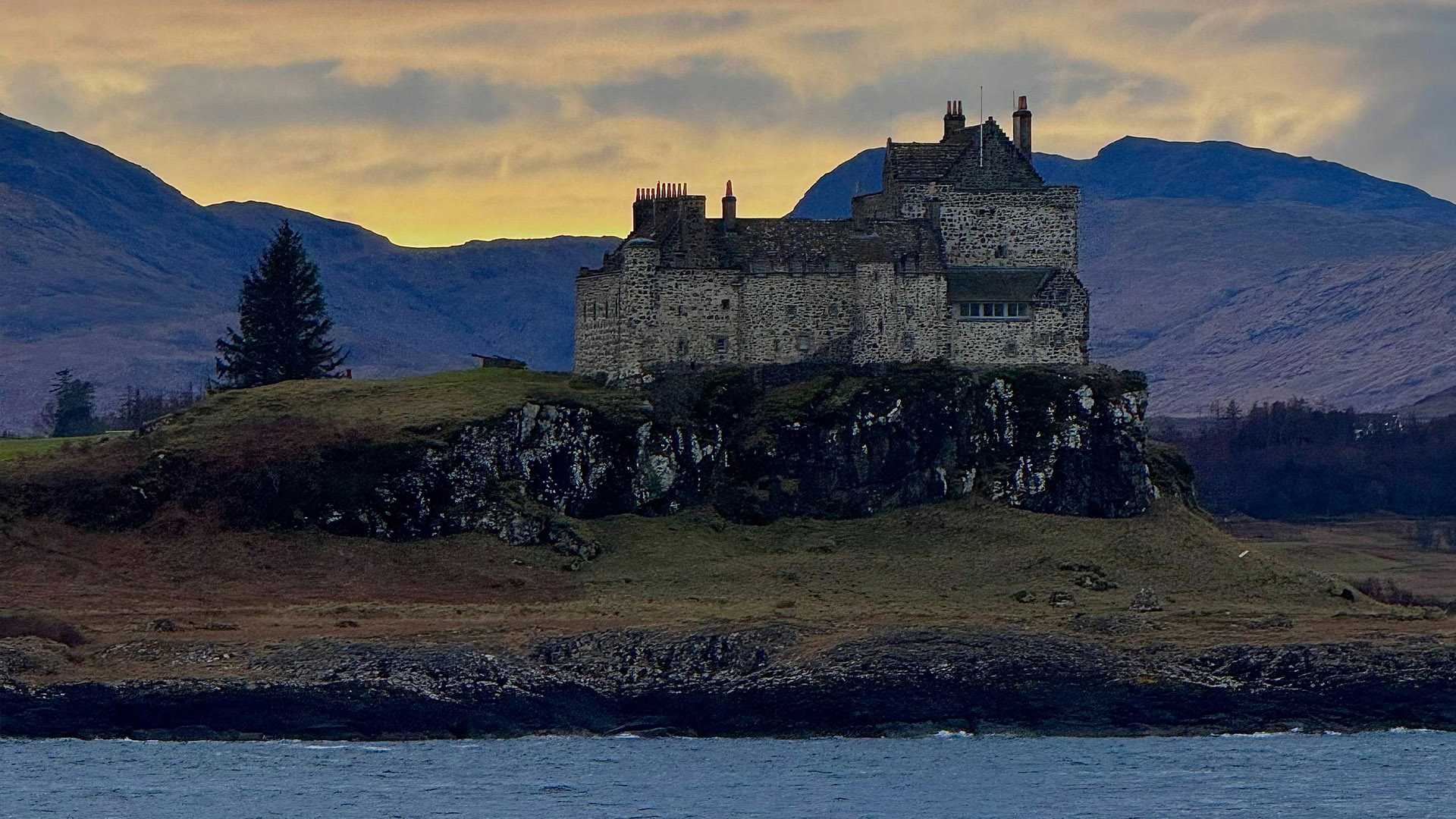
Duart Castle at sunrise.
More than merely a historical landmark, Duart Castle is the ancestral home and enduring seat of the Clan Maclean, one of Scotland’s oldest and most famed Highland clans. Its history, spanning over 800 years, is a compelling narrative of resilience, unwavering loyalty, fierce conflicts, and a remarkable modern restoration. It stands today as a living symbol of Scottish heritage and clan pride, embodying the turbulent yet proud spirit of the Highlands.
Ancient Roots: The Maclean Clan and Duart’s Beginnings
The lineage of the Clan Maclean traces back to the Thirteenth Century, with the clan name itself, Maclean, meaning ‘Son of Gillean’. This name is derived from Gillean of the Battle-Axe, a formidable warrior believed to be related to the ancient Kings of the Province of Dalriada. The traditional lands of the clan were, and continue to be, situated along the West Coast of Scotland, encompassing the islands of Mull, Coll, Tiree, and Jura, alongside mainland territories such as Morvern, Ardgour, Drimnin, and Dochgarroch.
While the Macleans would become inextricably linked with Duart, a fortification existed on the site long before their ownership. The castle’s origins are rooted in the 13th century, with historical accounts suggesting its initial construction was likely undertaken by Clan MacDougall. This early structure comprised a rectangular defensive curtain wall, enclosing a courtyard and establishing the foundational layout for the formidable stronghold that would later become synonymous with the Macleans.
The castle’s acquisition by the Macleans in 1367 marks a pivotal and dramatic moment in its history. Chief Lachlan Lubanach Maclean, the 5th Chief of the Macleans of Duart, sought a papal dispensation to marry Mary Macdonald, the daughter of the powerful John of Islay, Lord of the Isles. This union, reportedly a love match, was only sanctioned after Lachlan’s audacious act of kidnapping Mary’s father, an incident during which the Chief of the Mackinnons was tragically killed. As a dowry for this marriage, the Macdonalds granted the Mackinnon lands to the Macleans, which included a significant portion of Mull and Duart Castle itself. Lachlan Lubanach then proceeded to build the keep that stands today, although the great curtain walls are believed to predate his construction. The dramatic circumstances surrounding Lachlan Lubanach’s marriage, involving abduction and bloodshed to secure a dowry, vividly illustrate the often brutal and pragmatic nature of power acquisition and alliance-building in medieval Scotland. This historical episode highlights how even seemingly personal events like marriage could have profound geopolitical ramifications, directly shaping clan territories and determining the fate of strongholds such as Duart. This incident underscores the high stakes and ruthless tactics frequently employed in the pursuit of power and land during this tumultuous period.
A Fortress Forged: Architectural Evolution and Strategic Importance
Duart Castle’s design was inherently defensive, masterfully exploiting its natural position on a craggy peninsula. Its land-facing walls were extraordinarily thick, measuring up to ten feet (3 meters), while the sea-facing walls were up to nine feet thick, specifically engineered to withstand land-based assaults, which were the most common threat. Internally, narrow spiral staircases were meticulously designed to be defended by a single swordsman, rendering it exceptionally difficult for invaders to advance to the upper floors even if they breached the outer defenses. The castle’s commanding views over the Sound of Mull and surrounding waters provided an unparalleled vantage point, enabling early detection of approaching enemies and reinforcing its role as a vigilant sentinel.
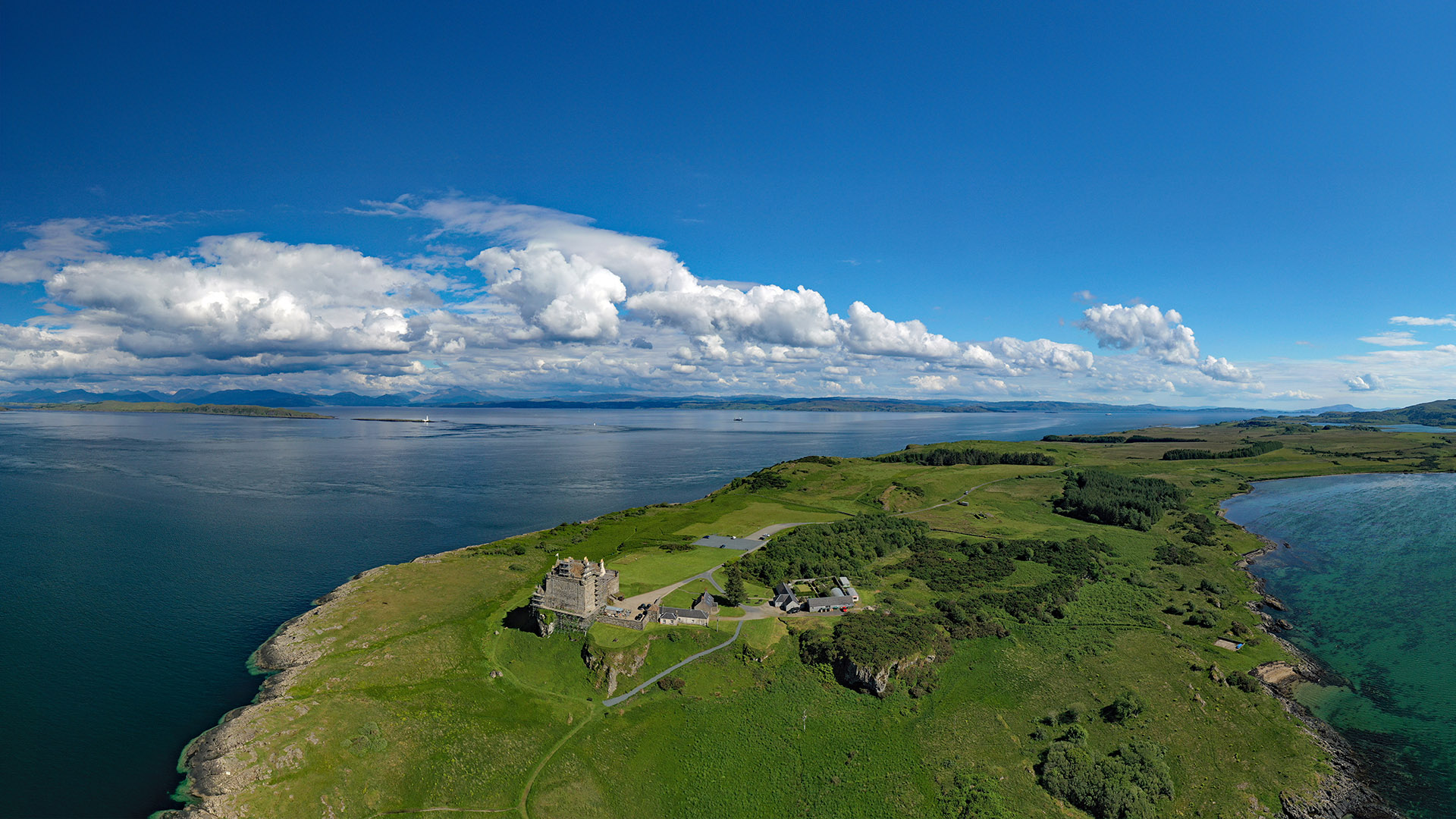
PaulT (Gunther Tschuch), CC BY-SA 4.0, via Wikimedia Commons
Duart Castle was not constructed in a single phase but evolved significantly over centuries, reflecting changing defensive requirements and improving living standards. Following its acquisition by the Macleans, Lachlan Lubanach Maclean built a substantial tower-house, or keep, which remains the core of the castle today, strategically enclosing the existing well within its formidable defenses. In the 16th century, under the leadership of Chief Hector Mor Maclean, who succeeded in 1527 and was known for his admirable character, the castle underwent substantial strengthening and enlargement. Hector Mor reinforced the South East buildings in the courtyard and added the prominent gatehouse, contributing to the castle’s present structure, which features a collection of strongholds surrounding a spacious courtyard. The North East range of buildings was also remodeled towards the end of this century. Later, in 1673, Sir Allan Maclean undertook further remodeling and reconstruction of the North East range, adapting the castle for both habitation and defense in response to the changing political landscape. The continuous architectural modifications and expansions of Duart Castle across the 14th, 16th, and 17th centuries illustrate a dynamic relationship between the clan’s evolving power and their physical stronghold. These changes reflect not only advancements in defensive architecture but also adaptations to changing living standards and the clan’s growing influence, transforming it from a basic defensive structure into a more complex, dignified, and habitable clan seat. The progression from simple defensive walls to vaulted cellars and a first-floor hall indicates a clear shift towards accommodating the increasing prestige and domestic needs of a powerful clan.
The strategic location of Duart at the junction of major sea lanes was paramount to the Macleans’ power. In an era before extensive road networks, seaways were the vital arteries of the islands, controlling trade, transit goods, and the movement of people. The Macleans, with their substantial fleet of Brigs and Birlinns, exerted an “iron grip” over the region through Duart’s formidable position, establishing their power base not only on Mull but across the Morvern peninsula and mainland ports of Argyll.
Turbulent Tides: Conflicts, Loyalties, and Clan Rivalries
Duart Castle was a constant witness to the tumultuous history of the Scottish Highlands, frequently finding itself at the heart of major conflicts. The Macleans were often embroiled in bitter inter-clan feuds, most notably with the MacDonalds. A brutal example of this rivalry is the Battle of Traigh Ghruinneart in 1598, where Chief Lachlan Maclean was killed, leading to his sons exacting a terrible revenge through a three-day massacre on Islay.
Intriguingly, Duart Castle also played a small yet significant role on the international stage. Following the defeat of the Spanish Armada in 1588, a badly damaged Spanish galleon, believed to be the Florencia, anchored in Tobermory Bay, a few miles north of Duart. Chief Lachlan Mor agreed to provide aid to the Spanish captain in exchange for troops and supplies to assist in his ongoing feud with the MacDonalds. However, the Spanish vessel was mysteriously blown up, with rumors persisting of large quantities of hidden Spanish gold. Subsequently, some Spanish troops were held prisoner in Duart’s dungeons, where models of these men can still be seen today.
During the English Civil War, also known as the Wars of the Three Kingdoms, the Macleans proved to be staunch Royalists, fiercely loyal to the Crown. Sir Lachlan, the 16th Chief, joined Montrose’s Highland Army. Duart Castle faced sieges in 1647 by Clan Campbell, who were backed by the English, and again in 1653 by General Oliver Cromwell’s forces. While the Macleans successfully drove off the Campbells in 1647, they had already fled to Tiree before Cromwell’s armada of six warships arrived in 1653. A providential storm then blew up on September 13th, sinking three of Cromwell’s ships, including the warship Swan, whose wreck was discovered in 1979 and yielded interesting artifacts now displayed at the castle. The castle’s survival through various sieges, particularly the Cromwellian one where a storm rather than direct defense thwarted the invasion, contributes to its unique claim as “one of the few castles in Scotland that never fell to military power”. This narrative element highlights the unpredictable role of external factors, including nature, in shaping the castle’s military history, adding a layer of dramatic irony and reinforcing its formidable reputation.
The Long Decline and the Campbell Ascendancy
The Macleans’ unwavering loyalty to the House of Stewart, particularly Sir Lachlan’s creation as a baronet by Charles I in 1631, ultimately proved to be their undoing. This steadfast devotion to the Stuart line, seen by many as the rightful rulers of Scotland, was severely punished through the forfeiture of their lands and castles.
The clan’s fortunes worsened significantly in the late 17th century. After the Restoration of Charles II in 1660, Sir Allan briefly regained control of Duart Castle, even remodeling the North East range in 1673. However, in 1674, the Earl of Argyll, a prominent member of the rival Clan Campbell, took possession of the castle from Sir Allan, pressing for the repayment of considerable debts. While the castle and lands were briefly returned to Sir John, Sir Allan’s son, in 1681 when the Earl of Argyll fell out of favor with the King, this reprieve was short-lived. The castle was lost again in 1691 when Argyll regained favor with the Whigs. The shift in power dynamics, where the Macleans lost Duart not through direct military conquest but through political maneuvering and accumulating debts, marks a significant change in the nature of power struggles in Scotland. This transition from battlefield might to legal and political entanglement illustrates how the clan system, once defined by martial prowess, became increasingly vulnerable to economic pressures and courtly influence.
Following its final loss to the Campbells, Duart Castle was partially demolished by them, with many original stones scattered and even reused to build cottages for the surviving Macleans. The castle, though occasionally garrisoned by government troops, was effectively abandoned after the Jacobite Rising of 1745 and left to fall into a ruinous state. For nearly two centuries, from 1691 until 1911, Duart Castle would not belong to the Maclean chiefs, becoming a roofless and derelict shell by 1748. This period of abandonment highlights the profound decline of the clan’s fortunes and the physical decay of their ancestral home, transforming it from a symbol of power into a stark reminder of their lost influence.
A Phoenix Rises: The 20th Century Restoration
The long period of dereliction came to an end in the early 20th century, thanks to the vision and determination of Sir Fitzroy Maclean, the 26th Chief of the Clan Maclean. As a young boy, Sir Fitzroy had visited the ruins of Duart Castle with his father and vowed to reclaim and restore the ancient ancestral home to its former glory. Fulfilling this vow, he purchased the ruinous castle in 1910 or 1911, separating it from the Torosay Estate, which had owned it since 1865. This act of reclamation, driven by a deep personal commitment, transformed a derelict ruin into a living symbol of clan identity and resilience, underscoring the enduring connection between the Maclean clan and their ancestral seat.
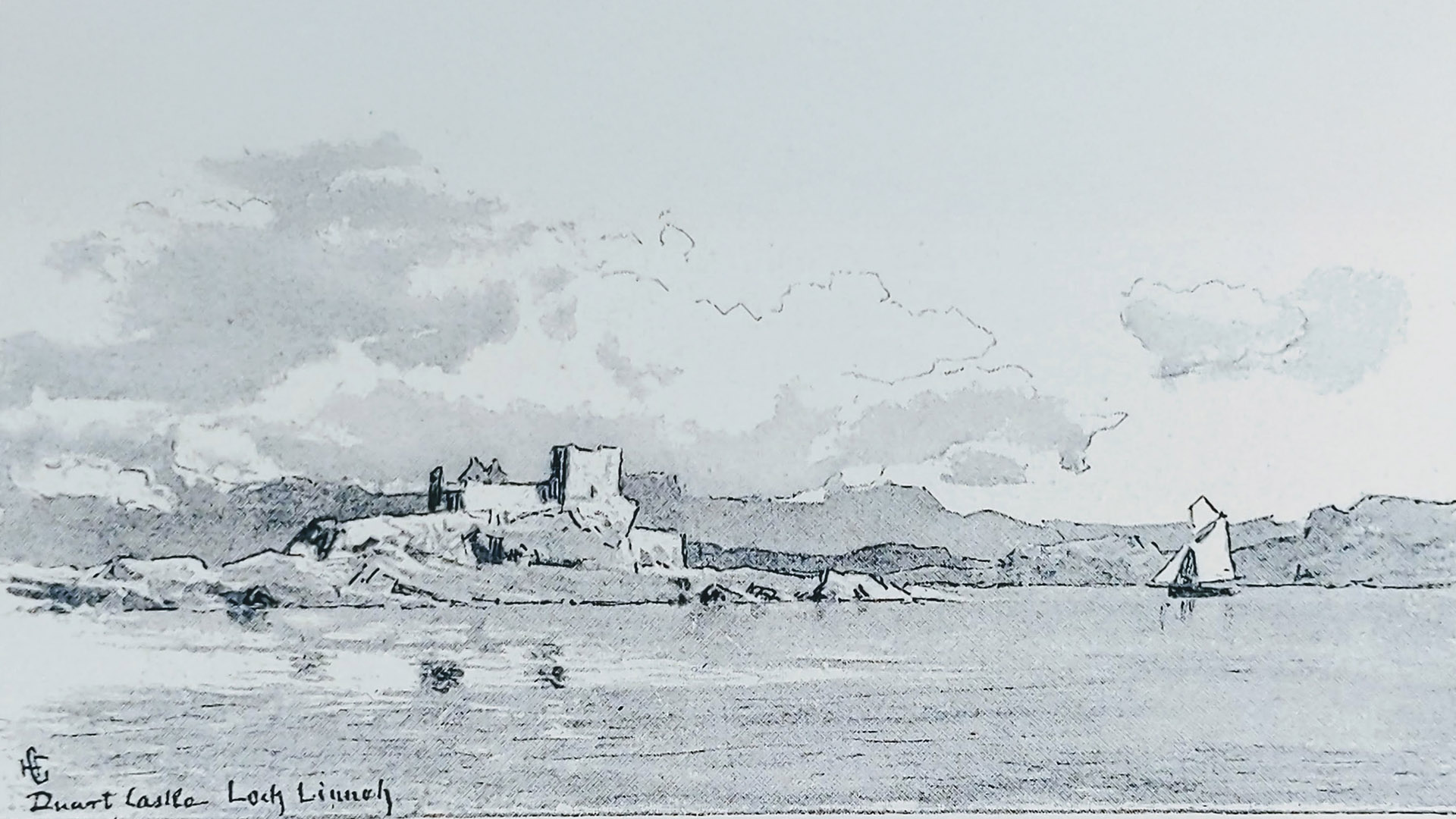
Duart Castle circa 1877 before extensive renovations: Hans Gude, Public domain, via Wikimedia Commons
The extensive task of repairing and restoring the building began immediately, with the restoration completed before World War I. Sir John James Burnet, an eminent architect working in London and Scotland, was responsible for the work. Unlike some other castle restorations of the era, the work at Duart did not attempt to create a new castle from scratch but was instead modeled closely on 18th-century surveys, aiming to restore it as a clan seat and family home of dignity. This ambitious scheme included the construction of a “modern” Edwardian house within the castle walls.
The restoration was a resounding success, and Duart Castle once again became the home of the Chief of Clan Maclean. This marked a significant resurgence for the clan, with Sir Fitzroy holding the first modern gathering of Clan Maclean at Duart in 1912 to showcase the restored castle. The castle’s reclamation and restoration solidified its renewed role as a powerful symbol of clan identity and a focal point for Macleans worldwide.
Duart Castle Today: A Living Legacy
Today, Duart Castle remains one of the last surviving privately owned Clan Castles in Scotland and is the oldest inhabited castle on Mull, serving as the home of the 28th Chief of Clan Maclean, Sir Lachlan Hector Charles Maclean of Duart and Morven. It is listed by Historic Scotland as a Category A building, signifying its national and international importance. While still a family residence, Duart Castle is fully open to the public and stands as one of the most visited historic sites on the Isle of Mull.
Visitors can explore the castle from April 1st to October 18th, with varying opening hours depending on the month. Admission fees apply, with discounts for seniors and students, and free entry for Historic Houses Association members. While there is no public transport directly to the castle from the Craignure Ferry Terminal, it is a pleasant three-mile walk, and local taxis are available.
The visitor experience offers a deep dive into history and culture. Guests can explore the Great Hall, adorned with family portraits and clan crests, and admire the robust walls, which range from 10 to 23 feet thick. The quaint Edwardian State Rooms, furnished for the wartime honeymoon of Lord Maclean, feature family photos and a collection of military uniforms and dresses dating back to 1750. The ghostly dungeons, where Spanish Armada prisoners were once held, offer a chilling reminder of the castle’s turbulent past. Walking along the ramparts provides breathtaking panoramic views of the surrounding coastline, including Mull, Loch Linnhe, the Morvern Peninsula, and the Sound of Mull. The castle grounds also feature woodland walks, picnic spots, and a tearoom where visitors can relax. The Millennium Wood and Duart Point peninsula offer additional opportunities for exploration and scenic views. A gift shop, curated by Sir Lachlan Maclean, offers clan-related souvenirs, history books, and other memorabilia.

Duart Castle view from ramparts.
Duart Castle is not only a historical site but also a vibrant cultural hub. It regularly hosts a variety of events throughout the summer months, including weddings, outdoor theatre performances, military re-enactments, music concerts featuring Scottish pipers and Highland dancers, and storytelling sessions. Its striking appearance has also made it a popular filming location for Hollywood feature films, including “Entrapment” (1999) starring Sean Connery and Catherine Zeta-Jones, “When Eight Bells Toll” (1971) with Anthony Hopkins, and “I Know Where I’m Going” (1945).
The preservation of Duart Castle is an ongoing effort. In 2012, Sir Lachlan Maclean, the 28th Chief, launched an international appeal to the Clan Maclean and history enthusiasts for help with much-needed repairs, as the family could no longer solely fund the upkeep. The Clan Congress unanimously supported this request, leading to the establishment of the Duart Restoration Fund and the Duart Appeal USA, a non-profit initiative to raise matching funds in cooperation with Historic Scotland Foundation. The castle, being in an extremely exposed location with high annual rainfall, requires continuous maintenance, with recent efforts focusing on repairing major water ingress. These efforts ensure that Duart Castle continues to stand as a testament to its rich history and enduring legacy for generations to come.
Legends and Lore
Beyond its documented history, Duart Castle is steeped in captivating legends and folklore that add to its mystique. One of the most infamous tales is that of “The Lady of the Rock.” In the 16th century, Chief Lachlan Cattanach Maclean, known for his brutal nature, attempted to murder his wife, Catherine Campbell, sister of the Earl of Argyll. After she reportedly tried to poison him, Lachlan dragged her from the castle, bundled her into a boat, and left her tied to a small rock only visible at low tide, intending for her to drown. Miraculously, Catherine was rescued by a passing fishing boat and returned safely to her Campbell kinsfolk. The rock where she was stranded is still known as Lady’s Rock and can be seen from the castle. Catherine’s younger brother, Colin, later avenged his sister by murdering Lachlan in Edinburgh.
Another chilling legend associated with Mull and the Macleans is that of “The Headless Horseman.” This spectre is said to be Ewen of the Little Head (Eoghan a’Chinn Bhig), the only son and heir of John, the fifth chief of the Maclaines of Lochbuie. In 1538, Ewen was killed in a clan dispute, his head severed by a Duart clansman. His ghost, riding a black charger, is said to haunt the roads of Mull, particularly prejudiced against the Duart Macleans. Tales recount Maclean men fending off the spectral attacker with their dirks until cock crow, leaving them exhausted but safe. The ghost has even been reported to visit the island of Coll, another ancient Maclean land, with his steed heard galloping furiously around the old keep of Moy when death or misfortune was about to afflict the house of Maclaine.
Conclusion
The history of Duart Castle is a microcosm of Scotland’s turbulent past, a narrative woven with threads of ancient clan origins, strategic architectural evolution, fierce loyalties, and bitter rivalries. From its probable 13th-century beginnings as a MacDougall stronghold to its pivotal acquisition by the Macleans in 1367 under dramatic circumstances, the castle consistently served as a powerful symbol of authority and defense. Its continuous architectural adaptations across centuries reflect the clan’s evolving power and their determination to maintain Duart as a formidable, yet increasingly dignified, clan seat.
The castle’s role in major conflicts, from inter-clan feuds to its intriguing connection with the Spanish Armada and its resilient stance during the English Civil War, underscores its enduring strategic importance. The eventual loss of Duart to the Campbells was not a military defeat but a consequence of shifting power dynamics, highlighting the increasing influence of legal and political maneuvering over traditional battlefield prowess. This period of abandonment and ruin, lasting nearly two centuries, transformed the castle into a poignant emblem of clan decline.
However, the 20th-century restoration, spearheaded by Sir Fitzroy Maclean’s profound personal vision, marked a remarkable resurgence. This effort not only reclaimed a physical structure but also revitalized Duart’s role as the living heart of the Clan Maclean, symbolizing their enduring identity and resilience. Today, Duart Castle stands as a vibrant, accessible historical site, welcoming visitors to explore its ancient walls, delve into its rich history, and experience the cultural legacy it embodies. The ongoing preservation efforts, supported by the clan and wider community, ensure that this magnificent fortress continues to guard the Sound of Mull, a testament to a history that is both turbulent and triumphantly enduring.


